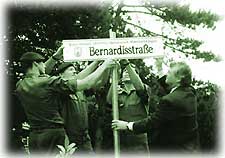Resistance und Persecution
Siegwald Ganglmair

According to the broad definitions of resistance against the Nazi regime outlined in this article not only the organized resistance groups of the Communist, Christian and Social Democratic camps, and the mycelium-like net of meeting and contact points are included, but also other expressions and attitudes of nonconformism and opposition. In other words clandestine and demoralizing expressions, “Schwarzhören”, “Schwarzschlachten”, “Rassenschande”, and contact with “foreign workers” and prisoners of war, which are sometimes referred to as the “Kleine Widerstand” (Small-scale Resistance).
Linz could not be called the centre of Upper Austrian resistance, but the main instruments of the terror in “Oberdonau” (the Gestapo, the SS, the SD, and the courts) as well as the party organizations, all of which are mentioned briefly, had their central seat in the provincial capital. By referring to the memorial stones, plaques, and the naming of streets after victims of the Nazi era which occurred after 1945, as well as by a short reference to literature, the author attempts to determine the perceived value of the resistance for post-war Linz and the province of Upper Austria in total.